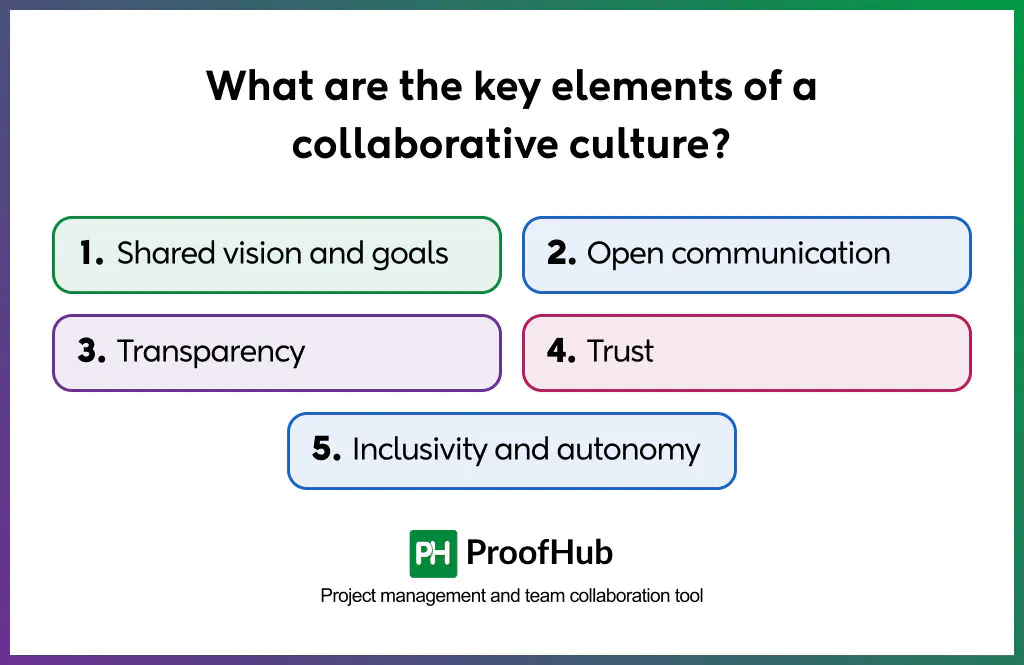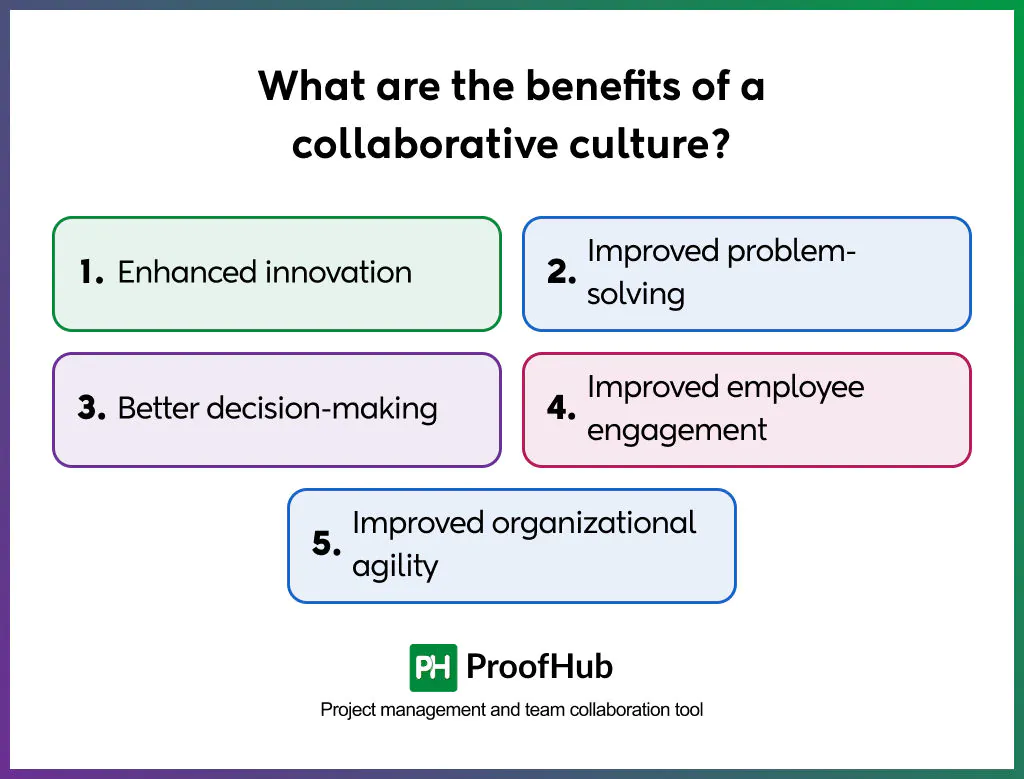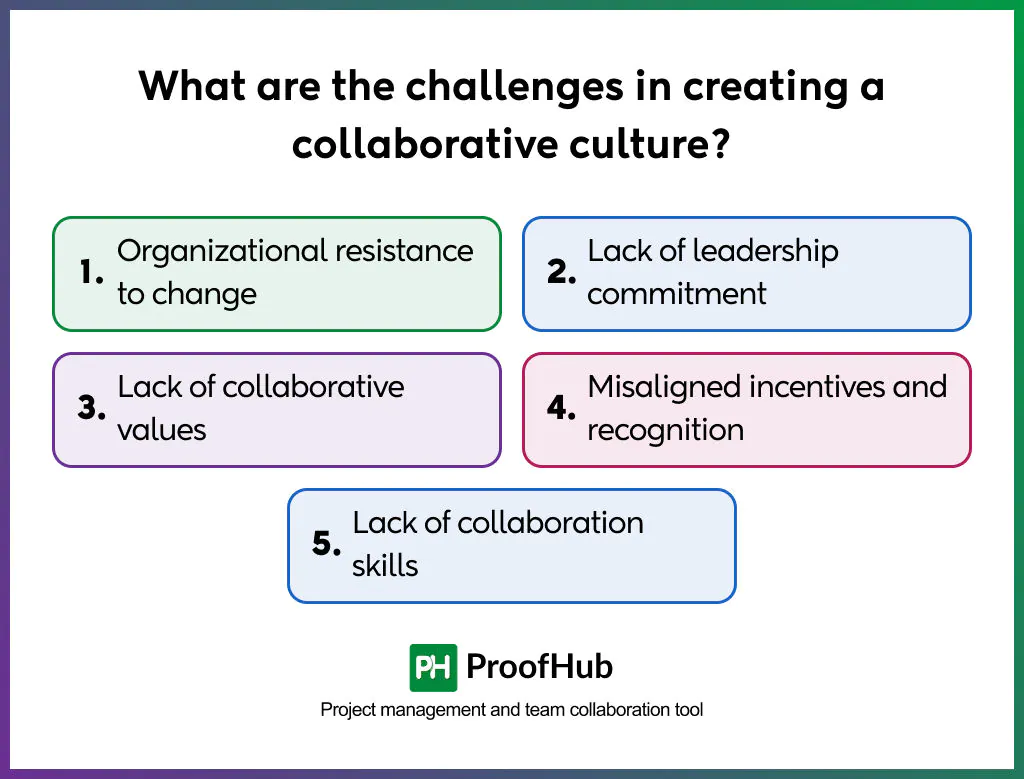
Collaborative culture in the workplace refers to an organizational environment where employees are encouraged and enabled to work together to pursue common organizational goals. It involves sharing knowledge, skills, and resources to find solutions to the problems collectively to achieve shared objectives.
Collaborative culture is characterized by trust, psychological safety, open communication, shared vision, goals, & values, inclusivity & diversity, transparency in decision-making, and empowerment & autonomy. These characteristics make collaborative culture different from hierarchical or siloed cultures, where information is not openly shared, power imbalance is prevalent, and decision-making is restricted.
Various studies consistently show that a collaborative culture offers numerous benefits for organizations, including improved innovation, better decision-making, enhanced problem-solving, stronger interpersonal relationships, increased employee satisfaction, better team performance, and improved organizational learning & resilience.
According to a McKinsey & Company study quoted in a World Journal of Advanced Research and Reviews paper, high-performing teams are up to 25% more productive than their less collaborative counterparts, highlighting the critical role of collaboration in enhancing organizational efficiency and performance.
Key elements of collaborative culture are trust, open communication, knowledge sharing, empowerment, supportive leadership, and the right tools and collaborative systems. Creating a culture of collaboration in the organization requires intentional leadership, clear communication, trust, & inclusive practices, recognition & rewards to incentivize collaboration, collaboration tools, platforms, and processes, and collaboration skills to support collaboration. However, challenges such as organizational silos, lack of trust, misaligned incentives, technology adoption barriers, and poor communication norms can hinder the development of such a culture.
In this post, we will explain what a collaborative culture is and how to create one within an organization.
What is collaborative culture?
A collaborative culture is a workplace environment where employees are encouraged and enabled to work together, share ideas, and solve problems collectively to achieve shared organizational goals. Key characteristics of a collaborative culture are shared vision & goals, open communication, trust & mutual respect, psychological safety, transparency, autonomy, and inclusivity.
Collaboration is different from teamwork, where individuals with specific roles come together within a team structure to work on interdependent tasks to achieve a shared goal. Teamwork relies on coordination and cooperation among team members on interdependent tasks, whereas collaboration involves working together by pooling knowledge, resources, and expertise to achieve a common goal.
The act of individuals working together, interacting with each other, and sharing diverse perspectives, skills, and resources to solve problems collectively makes a collaborative culture different from siloed and hierarchical structures where departments, teams, or individuals function in isolation. In hierarchical and siloed cultures, a lack of knowledge sharing, open communication, transparency, trust, and collaborative systems closes the opportunity to work together and utilize each other’s strengths.
A study by the Project Management Institute (PMI) found that organizational silos are a major barrier to successful project outcomes.
What are the key elements of a collaborative culture?
Key elements, or characteristics of a collaborative culture are shared vision and goals, open and transparent communication, psychological safety and trust, empowerment and autonomy, and recognition and reward.

1. Shared vision and goals
A collaborative culture is characterized by shared vision, goals, and values. Shared vision, goals, and values mean team members have a clear understanding of the common objective, how the individual’s contributions are connected directly to organizational objectives, and the role and responsibilities of each individual in achieving overarching organizational goals. It ensures alignment between individuals, teams, and the organization.
2. Open communication
Open communication is a key characteristic of a collaborative culture. It signifies free flow of information across all levels of the organization. Team members share updates, and leaders freely share news and information, including both successes and failures, with the employees. This creates an environment where everyone feels comfortable expressing thoughts without fear of criticism.
3. Transparency
Transparency means information is shared openly and decision-making processes are visible. It is essential to create a collaborative culture as it improves alignment of individuals with organizational vision, helps everyone understand the organization’s direction, and builds trust in the leadership and management with the dissemination of crucial information.
4. Trust
Trust is the foundation of any collaborative relationship. It means individuals feel safe to speak and open up, express opinions, propose ideas, and admit mistakes without fear of punishment. Trust creates the psychological safety for a collaboration to flourish.
Research by Edmondson (2022) underscores the importance of fostering psychological safety—a climate where employees feel safe to voice ideas and admit mistakes—to enable open collaboration.
5. Inclusivity and autonomy
Inclusivity and autonomy are the key features of a collaborative culture. Inclusivity means people from diverse backgrounds, experiences, and cultures are included and encouraged to share perspectives while working together and in decision-making. Autonomy empowers people to make decisions and take ownership and accountability for the decisions. Leadership plays a key role in creating a culture of collaboration by encouraging inclusivity & diversity and empowerment & autonomy.
What are the benefits of a collaborative culture?
Collaborative culture is based on the foundational idea of leveraging the collective intelligence, skills, and resources of the group to foster innovation, problem-solving, and learning that may not have been possible working in isolation. This act of collaboration in the workplace leads to enhanced innovation, improved problem-solving, better decision-making, improved employee engagement and retention, and enhanced organizational resilience.

1. Enhanced innovation
Collaborative culture enhances innovation by bringing together individuals with different backgrounds, experiences, and skill sets to share knowledge, viewpoints, and expertise. This results in the generation of new ideas and creative solutions, which might not happen if individuals are working independently in isolation.
A meta-analysis of the relationship between collaborative innovation and innovation performance by the School of Economics and Management, Tongji University, Shanghai, finds that collaborative innovation strongly and positively correlates with firms’ innovation performance.
2. Improved problem-solving
Collaborative culture improves the organizational ability to solve problems quickly and comprehensively. Collaboration brings together people with different skills, experiences, and perspectives who approach the problem from multiple viewpoints. This leads to better and more comprehensive solutions to the problem due to the diversity of viewpoints, skills, and knowledge.
A study featured in the Proceedings of the National Academy of Sciences (PNAS) found that teams with greater ethnic diversity were significantly better at solving complex problems.
3. Better decision-making
Collaborative culture makes the decision-making process inclusive and transparent. It empowers individuals to participate in decision-making and share opinions. The diversity of perspectives, skills, and experiences leads to fewer blind spots and improved critical thinking in making decisions. This leads to more comprehensive and better decision-making as multiple individuals are analyzing problems and finding solutions.
The white paper published by Cloverpop finds that inclusion and diversity help organizations make better business decisions 87 percent of the time and improve decision team results by 60 percent.
4. Improved employee engagement
A collaborative culture enhances employee engagement by offering employees opportunities to connect with one another. When individuals work on a shared objective and contribute to achieving common goals, it creates a sense of belonging and community within the team and the workplace. Additionally, working on interdependent tasks requires relying on and supporting each other. It helps build trust, mutual respect, and stronger interpersonal relationships. Team members celebrate achievements and support each other. This reduces the feeling of isolation and improves employee engagement.
Gallup research demonstrates that teams with higher collaboration deliver higher engagement rates and profitability.
Further, this collaborative culture in the workplace creates a positive work environment which directly improves employee job satisfaction and supports overall employee well-being, resulting in reduced turnover and better performance.
A Deloitte study found that 73% of employees engaged in collaborative work reported improved performance, and 60% felt collaboration directly reduced burnout.
This improved employee experience improves customer and stakeholder satisfaction as employees respond to client needs more effectively and deliver consistent service.
5. Improved organizational agility
Collaborative culture helps improve organizational agility by creating strong team connections, facilitating open communication, and promoting knowledge transfer, learning, and skill development of employees from their peers.
Research grounded in Vygotsky’s and Piaget’s theories, as detailed in a 2025 academic review, confirms that collaborative activities—like peer instruction, feedback, and group problem-solving—help students learn by teaching each other, developing self-regulation, and reinforcing concepts.
This free flow of information and collaborative learning helps create an organization that is ready to respond and adapt to change quickly and effectively. It makes it easier for organizations to pivot strategies to adapt to new market technologies, challenges, and opportunities. This organizational resilience ensures business continuity and long-term success.
How to build a collaborative culture at the workplace?
Creating a collaborative culture at the workplace requires the right organizational structure, environment, collaborative systems, norms, and policies. Here is a step-by-step guide to building a culture of collaboration at the workplace:

1. Evaluate the existing organizational culture
Evaluate the existing organizational processes, workflows, structure, culture, and tools. This cultural diagnosis will help identify areas that need improvement and changes to drive the organization towards creating a culture of collaboration. For example, if some processes or workflows are heavily individual-oriented or siloed, and these processes can benefit from collaboration, redesign the processes to make the most of the collaboration.
How to do it?
- Conduct a culture audit, including reviewing the current processes, workflows, policies, collaborative systems, and communication norms.
- Conduct surveys and interviews to identify barriers to collaboration and identify the processes that can benefit from collaboration.
2. Establish and communicate the vision
To build a culture of collaboration at the workplace, it is important to communicate the importance of collaboration to everyone. Establish a clear vision defining why the organization needs collaboration, how it fits into company goals, what it looks like, the role of each individual in creating a culture, and how it benefits everyone. It helps each individual understand the importance of collaboration and the role of each individual, ensuring participation in creating a culture of collaboration.
How to do it?
- Document and communicate the vision statement, shared purpose, and collaboration values.
- Clearly articulate the organizational goals and objectives, the role collaboration plays in achieving set goals, and the expectations from individuals in contributing to achieving those goals.
3. Structure a collaborative system
Structure a collaborative system that supports collaboration to create a collaborative culture. This will ensure everyone takes the collaboration seriously.
How to do it?
- Design processes and workflows to encourage collaboration.
- Establish and document clear collaboration principles, norms, and procedures to guide daily interactions.
- Use collaboration tools to create centralized spaces for communication and project collaboration. According to Gartner, nearly 80% of workers were using collaboration tools for work in 2021.
- Document and share collaboration values such as trust, inclusivity, and transparency, and integrate collaboration values into policies.
- Identify the leaders to lead the initiatives to create a culture of collaboration.
4. Recognize and reward the collaborative behaviour
Recognize and reward collaborative behavior to sustain the culture of collaboration. It means rewarding and recognizing contributions to group success, not just individual achievement. If you only reward employees who focus on working individually rather than collaborating with a team, it’s unlikely that individuals will see much reason to engage in collaboration. Therefore, reward teamwork to build a collaborative culture.
How to do it?
- Recognition can take various forms, from informal praise to formal incentives.
- Align incentive and recognition programs with collaborative team success. This recognition motivates employees to continue collaborating.
5. Measure and improve
To create and sustain a successful collaborative culture, it is important to measure the collaborative initiatives, take feedback, and make improvements.
How to do it?
- Use organizational metrics like employee Net Promoter Score (eNPS) and retention rates to track cultural indicators.
- Use 360-degree feedback, pulse surveys, and regular retrospectives to identify collaboration gaps. Feedback creates a cycle of improvement that strengthens trust and adaptability.
- Use data to refine collaboration initiatives and maintain momentum.
6. Create an environment to create opportunities for collaboration
Leadership needs to intentionally create collaboration opportunities to create a collaborative culture. Use intentional collaborative initiatives and strategies to create opportunities for collaboration in your organizational workflow.
How to do it?
- Build trust and psychological safety. Encourage individuals to speak up, voice concerns, and contribute ideas without the fear of consequences.
- Promote open communication. Encourage free flow of ideas and information. Create collaborative spaces and activities where employees can freely express ideas, debate respectfully, and contribute to problem-solving. Create cross-functional projects, co-planning sessions, “solution days” for joint problem-solving, regular forums, and brainstorming sessions to break down organizational silos.
- Strengthen interpersonal relationships. Encourage team members to help and support each other. It builds a sense of community where employees feel personally connected to their peers and the organization’s mission.
7. Leadership must model the collaborative behavior
Leaders must model collaborative practices to create a culture of collaboration. It is because without the active participation of the leaders, collaboration efforts remain isolated at the team level.
According to a study by Sage Journal, it is the responsibility of leaders to model collaborative behavior and promote involvement, build trust, develop people, and work collectively to create a collaborative culture.
How to do it?
Leaders can practice transparency, distribute authority to empower employees, allow employees to take on varied roles across the organization, request feedback, and invite ideas to create a culture of collaboration.
What are the challenges in creating a collaborative culture?
There are several pressing challenges in creating collaborative culture-related processes, people, and technology. Here is the explanation of those challenges and solutions to resolve them:

1. Organizational resistance to change
Resistance to change is the biggest challenge in creating a collaborative culture. Changing company culture means changing the old ways of working, processes, and habits. Many employees and leaders resist shifting to a more collaborative way of working because they are comfortable with traditional hierarchical systems or siloed working systems. Adopting new habits, ways of working, and processes may cause fear of losing authority, control, status, and familiar processes, or having to build new skills.
Solution:
- Communicate the importance of the change and the benefits of collaboration.
- Create change management initiatives. Use storytelling, workshops, and pilot projects to showcase the value of initiatives. Provide training and support to make employees ready for the change.
- Find collaborative leaders within teams to model collaborative behaviors and reduce resistance.
2. Lack of leadership commitment
If leaders do not actively model collaboration, employees are unlikely to adopt it themselves. Inconsistent leadership behavior undermines trust and makes collaboration feel optional rather than essential.
Solution:
Make leaders part of the change. Gain leadership buy-in and ensure leaders demonstrate collaborative behaviours in everyday actions to encourage collaboration, such as practicing transparency, inviting input, and recognizing team contributions.
3. Lack of collaborative values
Lack of shared vision, goals, and objectives, unclear roles and responsibilities, poor knowledge sharing, absence of trust, transparency, and open communication, inadequate leadership and team collaboration style, and unclear decision-making make collaboration difficult.
Solution:
- Document and communicate the collaborative values, such as trust, transparency, open communication, autonomy, and shared vision.
- Create an environment to support collaboration, such as using digital tools and creating policies to encourage collaboration.
4. Misaligned incentives and recognition
If individual performance is prioritized over team achievement, employees may focus on personal achievement over team success. Individuals may withhold information or compete instead of working together, which is detrimental to collective success.
Solution:
- Redesign the reward program and incentive structures to encourage team performance.
- Recognize and reward collaboration publicly, making it clear that organizational success is tied to collective contributions.
5. Lack of collaboration skills
Many employees lack the skills required for collaboration. These skills include a combination of soft skills and technological literacy, such as cross-functional teamwork, effective communication, conflict management, and the ability to learn to use digital tools. Thus, even with the right environment and tools, organizations often struggle with collaboration.
Solution:
- Provide soft skills training. Conduct intentional workshops, sessions, and collaborative activities focused on improving soft skills.
- Choose user-friendly collaboration tools. Provide ongoing training and support.
How can remote teams maintain a strong collaborative culture?
Remote teams can maintain a strong collaborative culture by using digital collaboration tools and establishing clear communication norms. Remote teams face unique challenges to collaboration due to distance. The foundational idea behind using digital collaboration tools is to replicate in-office collaboration for geographically dispersed team members.
To make the most of the digital collaboration tools, remote team members need a clear set of communication guidelines. For example, how to use each communication channel, when, where, and how to communicate, ideal response time, remote etiquette, and so on. This avoids confusion and streamlines the communication and collaboration.
In addition to that, just like in-office collaboration, remote teams need clear objectives and roles and responsibilities, shared understanding, psychological safety and trust, fairness & transparency, leadership support, and open communication & regular feedback to maintain the culture of collaboration.
Here are some collaborative practices you can follow to maintain a strong collaborative culture:
- Establish regular video meetings and virtual brainstorming sessions to keep everyone connected.
- Encourage informal virtual gatherings such as social coffee chats, fun activities, and on-site activities to strengthen connections.
- Use shared digital workspaces to promote transparency with open file sharing, progress tracking, and visible decision-making.
- Leadership should model collaborative behavior, set expectations for participation, and recognize contributions equally for remote and on-site staff.
- Training in digital collaboration tools and remote etiquette further enhances efficiency.
What are the signs of a poor collaborative culture?
A poor collaborative culture has siloed departments or teams, is resistant to open communication, and has lower employee engagement. The presence of organizational silos is one of the clearest signs that departments, teams, or individuals hoard information and do not share information and knowledge openly. This often leads to confusion, misunderstandings, and conflicts, creating inefficiencies in processes and workflows and duplicated efforts.
Resistance to open communication means employees fear speaking up. It happens because of the lack of psychological safety and trust. Team members hesitate to share new ideas and feedback because of the fear of criticism. It is visible in the meeting where a few voices are dominant while others are silent.
Lack of employee engagement, accountability, and ownership of tasks is another indication of poor collaborative culture. Low employee net promoter score, high absenteeism rate, reduced employee retention, and high employee turnover rate are key indicators of poor collaborative culture.
What are the key skills required to create a collaborative culture?
Creating a collaborative culture requires a blend of interpersonal, leadership, and technical skills across all levels of an organization. Key skills include active listening, effective communication, conflict resolution, emotional intelligence, adaptability, decision making, and technological literacy.
- Active listening: It is the ability to listen and understand other opinions and perspectives respectfully.
- Effective communication: It is the ability to share ideas and communicate messages clearly and effectively. Strong communication with transparency reduces misunderstandings and builds trust across teams.
- Conflict-resolution: It is the ability to listen, communicate, and solve problems to resolve conflicts. These skills are crucial for addressing disagreements productively.
- Emotional intelligence: it is the ability to understand and manage your own emotions, and those of others.
- Decision making: It is the ability to analyze situations, considering various perspectives, and choose the best course of action.
- Growth & learning mindset: willingness to learn, accept feedback, and iterate towards better solutions.
- Self-awareness and accountability make it possible for individuals to recognize their strengths and weaknesses and contribute positively.
- Technological literacy: The ability to use and learn digital collaboration tools, project management platforms, knowledge-sharing tools, and remote communication technologies.
What role does leadership play in creating a collaborative culture?
Leadership plays a vital role in building and sustaining a collaborative culture. Leaders create the foundation for a collaborative culture by articulating a shared vision for the collaboration, explaining the importance of the collaboration, investing in robust collaboration tools, designing workflows, policies, and norms, and creating recognition and rewards to celebrate team achievements. They sanction resources to facilitate collaboration across departments to break down organizational silos and encourage cross-functional teamwork.
Leaders set the tone for collaboration by modeling open communication, mutual respect, and inclusivity in daily interactions, nurturing psychological safety, and reinforcing these values through policies and everyday behavior to encourage collaboration.
What tools can help in creating a collaborative culture?
Organizations can use a range of digital tools to create a collaborative culture, which includes communication tools, document collaboration & cloud storage apps, project collaboration software, recognition and employee engagement software, and various other digital productivity tools.
Here is the list of popular digital collaboration tools:
- Communication tools: Slack, Microsoft Teams, Zoom
- Document collaboration apps: Google Workspace and Microsoft 365
- Project management software: ProofHub, Jira, Asana
- Employee engagement software: 15Five, Culture AMP, Bonusly
What is the difference between collaborative culture and teamwork?
Both collaborative culture and teamwork look similar with people working together, but they differ in depth and scope. Teamwork refers to the coordination of individuals within a group, on interrelated activities to achieve a shared goal. Whereas collaborative culture is a broader organizational environment with cross-functional and cross-departmental cooperation. Teamwork is more about coordination and cooperation of interrelated activities within a team, whereas a collaborative culture includes pooling knowledge, perspectives, and resources to achieve a shared goal and guiding how everyone, at every level, interacts.
Collaboration emphasizes leveraging collective intelligence and the strengths of the group, open communication, collective problem-solving, and shared accountability that transcend teamwork. In fact, teamwork is a component of collaborative culture, making collaboration successful.
What are the traits of organizations with strong collaborative cultures?
Organizations with strong collaborative cultures display certain characteristics or traits such as open & transparent communication across all levels, a shared vision with clear goals understood by everyone, trust and mutual respect among team members, diversity and inclusion, inclusivity & transparency in decision making, recognition for team-based achievements, strong social connections, and technology and physical spaces for ease of knowledge-sharing and spontaneous interaction. These traits create a strong collaborative culture in the organization, making organizations agile, adaptive, innovative, resilient, and efficient.
Can collaborative culture improve employee engagement and retention?
Yes, a collaborative culture significantly boosts employee engagement and retention. Collaboration fosters a sense of belonging and a shared purpose within the team and the workplace. When employees feel genuinely valued for their contributions, they are more invested in their work, leading to improved engagement, motivation, and satisfaction. Additionally, collaboration provides opportunities for interaction. These frequent interactions reduce social isolation and help build interpersonal relations, reducing workplace stress and improving employee retention.
Research consistently finds that employees in collaborative cultures report higher levels of morale, organizational trust, and intent to stay with their employer. Further, fostering collaboration not only strengthens current engagement but also makes the organization more attractive to talented new hires, driving long-term stability and success.






